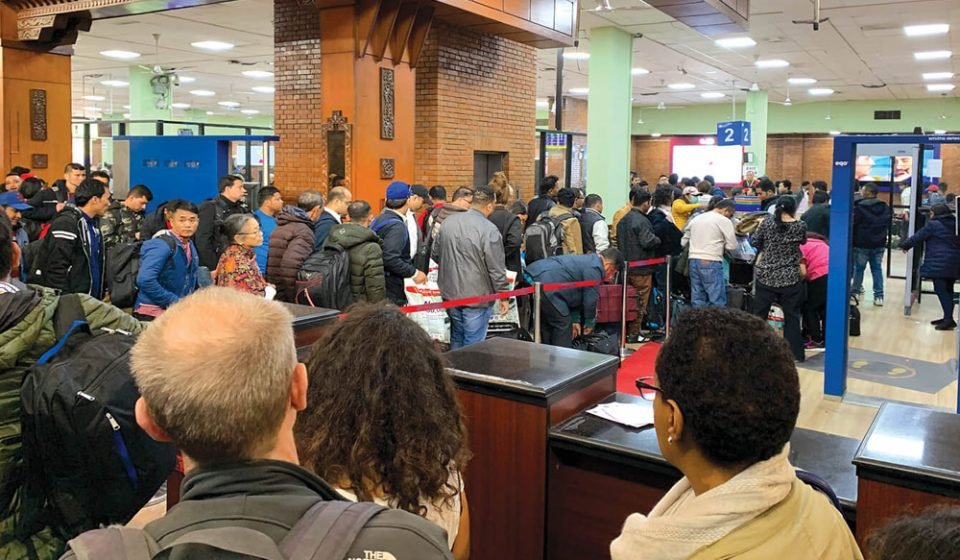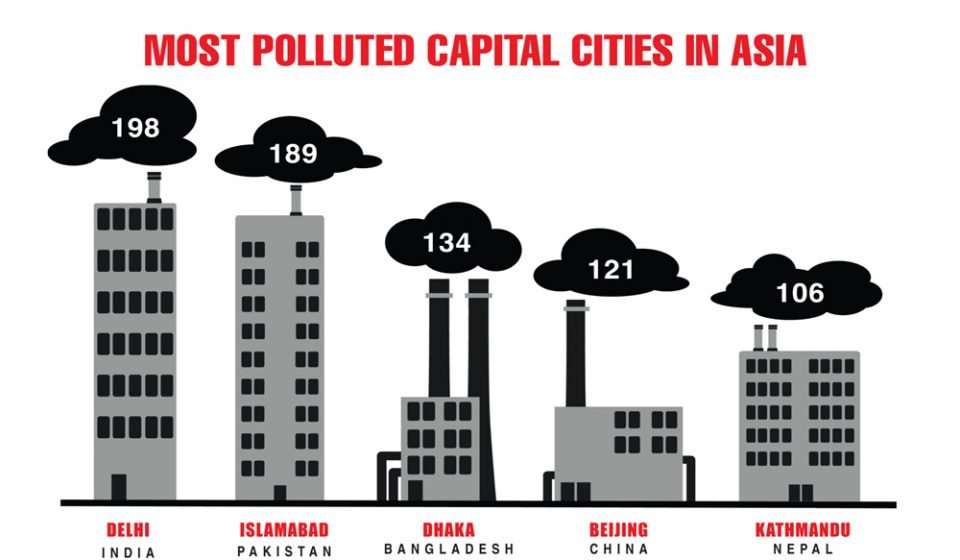
Kathmandu is the biggest city and the capital of Nepal. It’s additionally the main city in the nation with the Metropolitan City status. Kathmandu has a population of 985,000 as of 2019 and it seems the growth will keep on increasing.
Kathmandu makes up the center of the biggest urban cities in the Kathmandu Valley, which additionally incorporates Lalitpur and Bhaktapur. Casually, the city is called KTM or the tri-city.
Kathmandu represents 1/12 of Nepal’s complete population, and it’s the main gateway to the country’s tourism industry. The city has a history going back more than 2,000 years.

Expect to Wait for a Long Time for Visa
Arriving in Kathmandu just because can be overwhelming, particularly after a long flight. Try not to anticipate methodical lines or sorted out strategies. The arrivals corridor can by and large be portrayed as chaotic more often than not.

Kathmandu’s Tribhuvan International Airport certainly demonstrates some wear. Remain patient and battle for your place in the queues. Whenever dubious, ask somebody in a uniform, where to go. Nepal—an incredibly energizing, excellent nation—is standing by to be investigated simply outside!

After getting out of your plane, the knocking and bumping starts as you work your way through a progression of queues.
Standing in Queues
Try not to bounce into the main long line you see. Make no suspicions you’re in the right spot since every other person is holding up theirs. Search for the little billboards above work areas far to the front, and approach others in the queue for which part of the process are they waiting. Else, you could wind up holding up 30 minutes to the desk, then discover you were supposed to go to different desk first! A lot to the dismay of travelers, this situation happens much of the time.
Try not to expect methodical or courteous lining, particularly if hold up times are long. You’ll likely need to rearrange your feet and even stick out elbows to square endeavors to cut line before you. Individuals every now and again cut before one another given the briefest opening.
Fill online Nepal Visa Application Form Before your Arrival To Kathmandu
You can endeavor to finish the Nepal visa-on-arrival form on the web and print it before landing in Kathmandu airport. Travelers have detailed lots of issues with the form, including the way that the site is as yet not verified with https (no SSL Certificate- considered Unsecured). Your personal data will be sent over the web decoded. No compelling reason to trouble: You’ll still most likely need to get an arrival card and complete it in the air terminal hall.
This will help you to get through the arrival quickly.
Carry Descent Shape US Dollars
During your Kathmandu tour, if you are paying for your visa, meals or air tickets, in US Dollars, ensure dollars are in good condition and are in decent shape, not torn or too crinkled. Furthermore, if anything is written over it, badly folded, torn, or tampered, the bills will not be accepted. Damaged bills are rejected. Moreover, rejected as the Central Bank of Nepal will not accept damaged currency.

Carry Few Recent Passport Sized Photographs
During your Kathmandu tour, passport photographs come in handy; carry a few of your recent passport sized photos. It will be helpful when getting a SIM card for your mobile, applying for a TIMS card (if required) to go trekking in the Himalayas, and for different other permits (if required).
Don’ t Expect to See Mount Everest
Eight of the world’s 10 tallest Himalayan area in Nepal. You can see snow-topped mountains from Kathmandu, which lies in a bowl-formed valley in focal Nepal. However, for the captivating views of the transcending Himalayas, you should visit Kathmandu either in autumn time (October and November) or in the spring (April and May): February to early April is the best season, when woodland flames and smoke from “cut and-consume” cultivating over Nepal’s southern fields make a murkiness in the valley. Moreover, in case you’re fortunate, you can see Dorje Lhakpa (6,966 meters/22,854 feet), Ganesh Himal (7,422 meters/24,350 feet) and even Manaslu, the world’s eighth-most noteworthy mountain. However, if you some additional miles from Kathmandu, for example, the retreat towns of Dhulikhel and Nagarkot on the city’s edges—you may get a look at Mount Everest. However, if weather is very good followed by your luck you may have a tiny view of Mount Everest.
Learn Some Common Local Language
If your Kathmandu tour is for more than a week, you ought to give some time to learning a couple of common and well descent local language.
You can say “Malai Thaha Chhaina” (I don’t know) to the ever-curious Nepalis who may besiege you with inquiries concerning your nation’s governmental issues. Saying “Dhanyabad” (thank you) can do some incredible things. “Namaste” is the welcome and goodbye, and it’s done joining two palms together. Furthermore, other helpful words incorporate “Bhai” (youthful sibling) or “Dai” (more seasoned sibling) and “Didi” (more established sister) or “Baini” (more youthful sister) since Nepalis utilize these words rather than names to address individuals, even outsiders.
It’s not simply your absolute best at gathering local people and discovering what any given spot is like, but at the same time it’s a method for being a respectful traveler.
Notwithstanding the way that numerous individuals around the globe communicate in English, most may be offended on the off chance that they feel guests in their nation anticipate that they should talk and get English.
Adopt to Nepal Timings
Nepalese does not pay attention to punctuality. However, if you are booking Kathmandu tour through travel agents, the travel agents have learned to be punctual as primarily tourism is their bread and butter. Furthermore, most arrangements and gatherings more often than not, occur an hour after they are planned, which local people mockingly call “Nepali time.”
People may have genuine reasons, for example, roads turned parking lots, yet for the most part, it’s down to their casual frame of mind towards them. Moreover, appearing an hour late for an arrangement is a standard, not an exemption. This laid back disposition is reflected in services, for example, transportation, with transports and flights not leaving—and landing—on schedule, or government officials making you sit tight for quite a long time. There’s no chance to get around it. You’re free to be on schedule, and pause, obviously.
The solution is this that you should book your Kathmandu tour through one of the best Nepal travel operators.
Travel Admirably
Getting around Kathmandu can be overwhelming. The city doesn’t have an efficient mass-travel system in place, and to the uninitiated, the traffic looks tumultuous: drivers don’t adhere to traffic rules, transports stop in the street, and transport travelers are packed into each extra inch.
There aren’t such a large number of choices: You should jump onto a packed minibus or flag a cheating taxi. On the off chance that you do the last mentioned, you should demand that the driver runs the meter, and in case that driver reject, don’t be hesitant to wrangle. For local people, the cabbies regularly charge 100 rupees for every kilometer, except they may attempt to knock that up for foreigners.
Once you know the distance, attempt to negotiate the fare. Then again, there is Tootle, a motorbike rent application that matches you with motorbike drivers, or Sarathi, a taxi sharing organization. Sajha Yatayat—an agreeable that works transports in the city—offers conventional open vehicle.
Don’t Forget Mask
Kathmandu is positioned as one of the most polluted cities in the world. Hence, it is mandatory to bring a mask during your Kathmandu tour.

Residue from street extending ventures, post-quake constructions, carbon emission from brick factory close to the city, and obviously, the smoke-burping vehicles that stay on the streets on account of careless implementation of guidelines, have all added to the city’s developing air pollution. The city’s traffic division and the local authorities have attempted to keep the air clean by prohibiting vehicles more seasoned than 20 years.

Moreover, a year ago, the specialists additionally proclaimed the traveler hub of Thamel and inward pieces of the city a sans vehicle zone, which means autos, trucks, and little transports were not permitted to drive. While these endeavors have had some effect, the best security against contamination is a veil. Hence, bring mask from home or you can purchase in the department stores in Kathmandu.
Comments
Post a Comment
Thank you for your valuable feedback